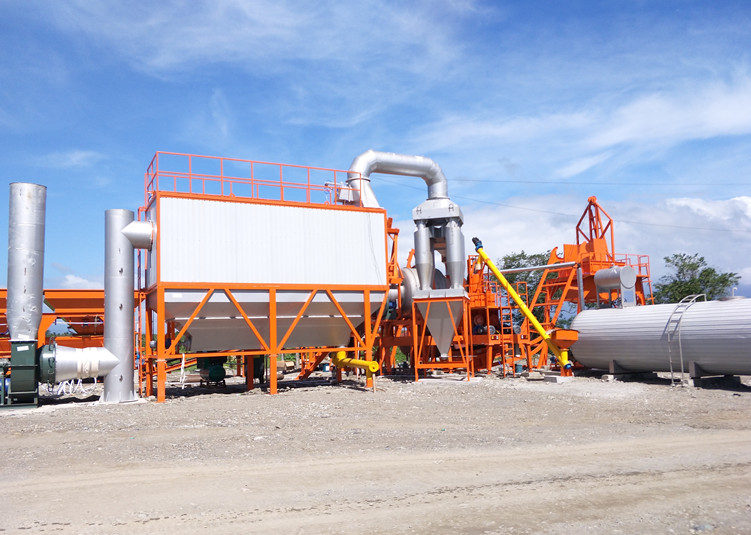What Is Mobile Asphalt Plant?
Mobile asphalt mixing plant is a kind of equipment that mixes stone, asphalt and mineral powder according to a certain proportion to produce asphalt mixture. Compared with the fixed asphalt station, the unique walking system makes the transition more convenient.
Types of Mobile Asphalt Mixing Plants
Asphalt plants are categorized based on their migration characteristics into stationary asphalt plants and mobile asphalt plants. Among the mobile asphalt plants, two primary types exist: the drum type and the forced type.
Mobile Asphalt Drum Mix Plant
The mobile asphalt drum mix plant consists of essential components such as the cold material supply system, asphalt supply system, drying and mixing drum, dust removal system, walking system, and control system. Typically utilized for small to medium-sized roads or low-grade road construction projects, it offers advantages such as a small footprint, easy mobility, and cost-effectiveness.
Main Workflow:
1. Utilize a loader to load cold aggregates of varying specifications into the respective cold aggregate hopper. The aggregates are then conveyed to the vibrating screen via a belt conveyor, with materials smaller than 40mm advancing to the next step.
2. Qualified cold aggregates are sent to the drying and mixing drum via a belt conveyor. Simultaneously, asphalt is transported to the drum through a pipeline. The cold aggregate and bitumen undergo mixing and drying within the drum, resulting in a homogeneous finished bitumen. Throughout this process, dust from the cold aggregate is directed into the dust collector, preventing environmental pollution.
3. The finished asphalt is subsequently lifted to the asphalt storage bucket by a bucket elevator for temporary storage and insulation, awaiting transport by dump truck to the construction site.
Mobile Asphalt Forced Mix Plant
The components and workflow of a mobile asphalt forced mix plant closely resemble those of a stationary asphalt plant. The key distinction is the incorporation of a walking system, enhancing mobility.
Utilizing a forced mixer, this plant ensures a thorough mixing of cold aggregate and asphalt, resulting in a high-quality finished product. Primarily employed in the construction of expressways and airport roads that demand stringent quality standards, the mobile forced asphalt plant is characterized by a high degree of automation, precise finished product specifications, and convenient transportation.
Main Workflow:
1. Loading Cold Aggregates:
- Use the loader to load cold aggregates of different specifications into the collecting hopper.
- After primary weighing, qualified materials are conveyed by the belt conveyor to the drying drum for heating and drying.
2. Drying Process:
- During the drying process, dust and moisture present in the cold aggregate are drawn into the bag dust collector.
3. Screening and Storage:
- The hot aggregate, heated by the drying drum, is elevated by the hoist to the vibrating screening system above the mixing building.
- After screening by the vibrating screen, the materials are sorted into different specifications and enter their respective storage hoppers.
- Subsequently, based on specific ratios, they are sequentially fed into the weighing device for re-weighing.
4. Weighing Mineral Powder and Bitumen:
- The mineral powder is conveyed to the temporary storage hopper via the powder elevator and then to the weighing device for measurement.
- Simultaneously, the bitumen is sent through a pipeline to the bitumen metering device for weighing.
5. Mixing Process:
- Combine the weighed aggregate, mineral powder, and asphalt in the twin-shaft mixer sequentially for thorough mixing.
- Upon reaching the specified time, open the discharge door of the mixer and transfer the evenly mixed mixture to the finished product warehouse.
6. Transportation to Construction Site:
- Finally, load the mixture into the dump truck for transportation to the construction site.
How to Choose a Site for a Mobile Asphalt Plant?
With the rapid expansion of infrastructure projects, the demand for asphalt mixing plants is on the rise. The selection of the site for a portable asphalt mixing plant plays a crucial role in its long-term operational efficiency.
1. Distance from Construction Site:
- The optimal haul distance is essential to maximize the profitability of the mobile asphalt mixing plant and ensure the quality of the asphalt mixture.
- Considering factors such as paving temperature and transportation economy, it is advisable to keep the distance between the asphalt plant and the construction site within a reasonable range.
- A recommended guideline is to have a transportation distance within 80 kilometers, with a maximum limit of 100 kilometers.
2. Ease of Raw Material Supply:
- Mobile asphalt plants necessitate substantial quantities of sand, slag, asphalt, and fuel for the combustion system (oil or natural gas).
- The site selection should prioritize the timely supply of these raw materials and consider the associated transportation costs.
Selecting the right location for a mobile asphalt plant is pivotal for efficient operations and the overall success of infrastructure projects.
3. Geological Conditions
Consideration must be given to potential geological threats at the chosen site, such as the presence of fractures, landslides, or areas with substantial stagnant water. The nature of the soil, whether it is sandy, also significantly impacts the foundation construction of the asphalt mixing plant. These factors directly influence the overall construction costs associated with the asphalt plant.
4. Surrounding Environment
Asphalt mixing plants involve high levels of mechanization, leading to the inevitable generation of pollution in the form of dust and noise during processing. Hence, in selecting a construction location, it is crucial to avoid areas with schools and residential communities as much as possible. This precautionary measure aims to minimize the impact on the surrounding environment and the well-being of local residents.














